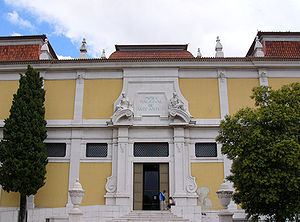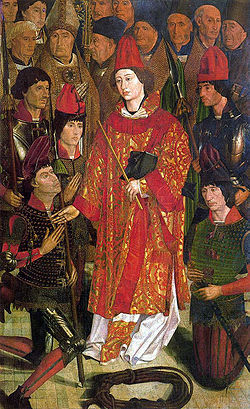- National Museum of Ancient Art
-
The Museu Nacional de Arte Antiga (Portuguese pronunciation: [muˈzew nɐsiuˈnaɫ dɨ ˈaɾtɐ̃ˈtiɡɐ]), located in Lisbon, is an art museum in Portugal.
The museum is known as MNAA (in English, National Museum of Ancient Art), and is popularly known as the Museu das Janelas Verdes (Green Windows Museum) due to the color of its windows. It is located in the Palácio de Alvor-Pombal, a former palace of the Count of Alvor, later purchased by the Marquis of Pombal.
It is the best museum in which to understand the development of Portuguese art prior to the early nineteenth century.
Contents
History
Founded in 1884, the National Museum of Ancient Art is located near the Tagus river. It occupies the palace of the counts of Alvor, dating from the seventeenth century, and the old convent of Santo Alberto. The chapel of the convent is a fine example of 18th Portuguese Baroque art and architecture and is incorporated into the exhibits.
Collection
The museum collection includes painting, sculpture, metalwork, textiles, furniture, drawings, and other decorative art forms from the Middle Ages to the early nineteenth century. The collections, especially those for the fifteenth and sixteenth centuries, are particularly important regarding the history of Portuguese painting, sculpture, and metalwork.
Painting
Perhaps the most famous work kept in the museum are the Saint Vincent Panels, which date from before 1470 and are attributed to Nuno Gonçalves, court painter of King Afonso V.
The six large panels show people from all levels of late medieval Portuguese society venerating Saint Vincent, in one of the first collective portraits in European art. There are sixty portraits on the panels.
The museum also has important works by early sixteenth century painters active in Portugal, such as, Jorge Afonso, Vasco Fernandes, Garcia Fernandes, Francisco de Holanda, Cristóvão Lopes, Gregório Lopes, Cristovão de Figueiredo, Francisco Henriques, Frei Carlos, and others.
Painting from the 17th through the early 19th centuries is well represented by works that include those of Josefa de Óbidos, Bento Coelho da Silveira, Vieira Portuense, Domingos Sequeira, and Morgado de Setúbal.
Portuguese metalwork is another highlight of the museum. Among its collection are outstanding pieces from the 12th to the 18th centuries. One of the most notable examples is the famous monstrance of Belém. It might have been made by the playwright, actor, and poet, Gil Vicente. According to an inscription on the monstrance, it was created out of some of the first gold brought back to Portugal from India by the explorer, Vasco da Gama.
The European painting section of the museum is significant and is represented by Jacob Adriaensz Backer, Bartolomé Bermejo, The Temptation of St. Anthony by Hieronymus Bosch, Pieter Brueghel the Younger, David Gerard, Saint Jerome by Albrecht Dürer, Lucas Cranach, Piero della Francesca, Jan Gossaert, Hans Holbein the Elder, Pieter de Hooch, Adriaen Isenbrandt, Quentin Metsys, Hans Memling, Antonis Mor, Joachim Patinir, Jan Provost, Raphael, José Ribera, Andrea del Sarto, David Teniers the Younger, Tintoretto, Anthony van Dyck, Diego Velázquez, David Vinckeboons, Hendrick Cornelisz Vroom, Francisco de Zurbarán, François Boucher, Nicolas Poussin and others.
External links
- (Portuguese) MNAA - Museu Nacional de Arte Antiga
- (English) Information about the museum
Coordinates: 38°42′15.90″N 9°09′42.49″W / 38.704417°N 9.1618028°W
Categories:- Museums established in 1884
- Art museums and galleries in Portugal
- Museums in Lisbon
- National museums of Portugal
Wikimedia Foundation. 2010.


